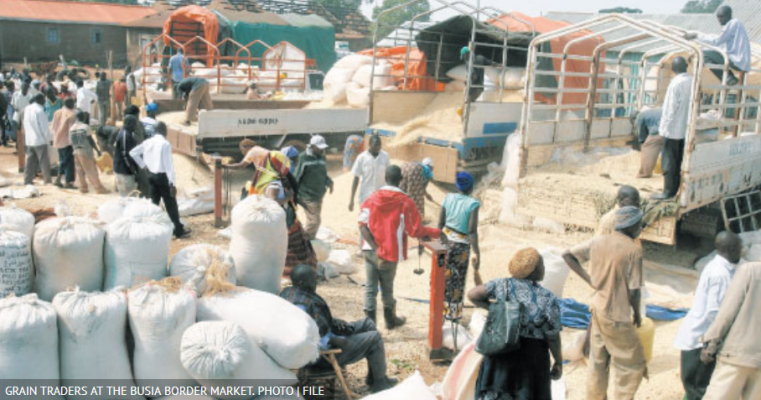Cross-Border Traders from both Uganda and Kenya have applauded both their governments for implementing the Electronic Single Window; a paperless platform that leverages technology to facilitate private sector trade through allowing for electronic submission of information, documentations and processing of import, export & transit related trade documents and requests.
Speaking during a November trade visit to traders, customs agents and trade facilitating agents at the Busia One Stop Border Post (OSBP), Charles Achieng, the chairperson Cross-Border Traders’ Association noted that prior to the introduction of the electronic single window, traders encountered lengthy, costly and time-consuming processes of moving from one agency toanotherlooking for permits, chasing documents verifications and approvals.
“Because of the many agencies involved, definitely it took long time to clear goods and therefore, there existed congestion at the borders and ports. Ultimately this would end up pushing up the cost of doing business and compromise the competitiveness of the country. Manual systems also encouraged and facilitated environmental degradation because of the many papers and file bags used. Plus, some people also benefited from these lengthy processes through corruption,” Mr Achieng said.
Trading made easy
Achieng noted that since its roll-out, the electronic single window has improved trade processes, strengthened accountability, tackled revenue leakages, reduced costs of doing business, eliminated bureaucracies, reduced corruption and adopted genuine players in to the trade process.
He said: “Single Window is faster, cheaper, paperless, convenient and very efficient. It has intelligence to disseminate information to all agencies that process, verify and approve trade documents. It coordinates cargo clearance, insurance issues and enables cargo tracking. Importantly, the single window is at this point facilitating the integration of the East African Community, taking in to account that the many agencies involved now have a podium to interact and exchange ideas, and compare data.”
These sentiments were supported by other trade participants.
Eric Onyango, a Ugandan Customs Agent at the BusiaOSBP noted that the Uganda Electronic Single Window system is good, has simplified trade procedures and very advantageous to all stakeholders involved.
“I urge the government to fast track the system roll-out to all agencies involved and also educate traders and customs agents on how this system works,” Mr Onyango said.
Clearance time reduced
Middy Amule, a Trade Information Desk Officer at the Busia Uganda Revenue Authority (URA) office noted that the Single Window is improving trade and also giving her office more room and time to facilitate small scale traders.
“Prior to adoption of the single window, the documentation was so much and several bureaucracies were involved. But with the single window, the work load for traders, trade officers and customs agents hasreduced. But this doesn’t mean that we no longer have work to do. At my desk, we continue to facilitate traders through issuing simplified certificates of origin for small traders who handle goods (exports and exports) worth USD 2000 and below. URA has authorized the information desk team as the only issuing institution for these certificates to small traders. We operate hand in hand with our partners in Kenya under the same roof of One Single Border Post,”Amule said.
Nonetheless, Onyango noted that just like any other new system, the Electronic Single Window still has some ‘teething issues’ that ought to be urgently addressed by the project leaders.
“One of the major challenge is connectivity and network instability. It is very hard to convince a trader used to going to customs desk to process documents that there is no network so they can’t be served. The other issue is systems interfaces. Since all these related organizations have been merged in to one window, some times you find a challenge that one agency is hanging. This one agency will hold you until when that problem is sorted,” Onyango stated, adding;
“There is also an issue of correspondence. Under this new arrangement, we are not supposed to have eye to eye contact with the traders. But we still have that culture whereby sometimes you can send an email and no one responds to it. You realise that at the end of the day, if you don’t call that person and talk to them, then nothing will proceed.”

Gilbert Juma, a clearing agent at the Busia OSBP, Kenya said noted that several traders are also not aware of this platform thus never understand when you tell them that there delays on the system.
“In our daily work, the biggest challenge we experience with some traders is that they are not aware of this system. So, at times you tell them that there is a delay caused by system instability, they will never understand how this system affects their trade. All they know is that once they have paid their taxes, they should be allowed to go with their goods. They don’t know that we are no longer moving from one office to another but rather doing everything online,” Gilbert Juma said.
In Uganda, the National Electronic Single Window was rolled in November 2016 while in Kenya, KenTrade – National Electronic Single Window System was launched in 2014. In both countries, the single window systems are implemented by the sitting governments, supported by TradeMark East Africa, DANIDA, UNCTAD and other development partners.










